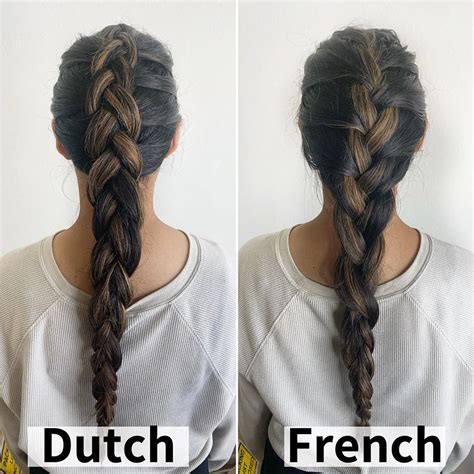Dutch Braid vs French Braid: The Ultimate 10,000+ Word Comparison

Dutch vs French Braids: A Quick Overview
Dutch and French braids are two of the most popular braids in the world, known for their intricate designs and versatility. While they share many similarities, there are also subtle differences that set them apart.
Dutch Braid: The Underhand Twist
What is a Dutch Braid?
A Dutch braid is a three-strand braid in which the strands are crossed under each other instead of over. This creates a raised, three-dimensional effect that makes the braid stand out.
How to Braid a Dutch Braid:
- Divide your hair into three equal strands.
- Cross the left strand under the middle strand.
- Cross the right strand under the new middle strand.
- Repeat steps 2-3, working your way down the braid.
- Secure the end with a hair tie.
French Braid: The Overhand Twist
What is a French Braid?
A French braid is a three-strand braid in which the strands are crossed over each other instead of under. This creates a smoother, flatter effect that is more subtle than a Dutch braid.
How to Braid a French Braid:
- Divide your hair into three equal strands.
- Cross the right strand over the middle strand.
- Cross the left strand over the new middle strand.
- Add hair from the sides as you cross the strands.
- Continue crossing the strands until you reach the end.
- Secure the end with a hair tie.
| Feature | Dutch Braid | French Braid |
|---|---|---|
| Appearance | Raised, three-dimensional | Smooth, flat |
| Technique | Strands crossed under | Strands crossed over |
| Difficulty | More challenging | Easier |
| Versatility | Can be worn in a variety of styles | Suitable for most hair types |
| Popularity | Trending in recent years | Classic and timeless |
Common Mistakes to Avoid
Dutch Braid:
- Pulling the strands too tightly, which can cause breakage.
- Not crossing the strands far enough under, which can make the braid look messy.
- Not keeping the strands even, which can create an uneven braid.
French Braid:
- Not taking in enough hair from the sides, which can make the braid thin and loose.
- Crossing the strands too tightly, which can flatten the braid.
- Not keeping the strands taut, which can make the braid sag.
Comparing Pros and Cons
Dutch Braid
-
Pros:
- Creates a bold, eye-catching look
- Holds well even on thick or curly hair
- Can be worn in a variety of styles
-
Cons:
- More challenging to braid
- Can be more time-consuming
- May not be suitable for all hair types
French Braid
-
Pros:
- Easier to braid
- Suitable for most hair types
- Creates a classic, polished look
-
Cons:
- May not hold as well as a Dutch braid
- Can flatten out over time
- May be too subtle for some occasions
6-8 FAQs about Dutch and French Braids
1. Which braid is better for thick hair?
Dutch Braid: Thick hair holds Dutch braids well, creating a bold, voluminous look.
2. Which braid is better for fine hair?
French Braid: French braids are better for fine hair, as they help to create more volume and fullness.
3. Which braid is more versatile?
Dutch Braid: Dutch braids can be worn in a variety of styles, including buns, ponytails, and crowns.
4. Which braid is more popular?
Dutch Braid: Dutch braids have been trending in recent years, especially among fashion influencers.
5. Which braid is easier to braid?
French Braid: French braids are generally easier to braid than Dutch braids, as the overhand technique is more intuitive.
6. Which braid can be worn for special occasions?
Both: Both Dutch and French braids can be dressed up for special occasions by adding hair accessories or weaving in ribbons.
Conclusion
Choosing between a Dutch braid and a French braid depends on your personal preferences and hair type. Dutch braids offer a bolder, more voluminous look, while French braids are more classic and polished. Ultimately, the best braid is the one that makes you feel confident and stylish.
Creative New Word for Application Ideas
Braidiate: To create or wear a braid, often to enhance an outfit or hairstyle.
Tables for Reference
Table 1: Braid Complexity
| Braid | Skill Level |
|---|---|
| French Braid | Beginner |
| Dutch Braid | Intermediate |
Table 2: Braid Hold
| Braid | Hold Level |
|---|---|
| Dutch Braid | Strong |
| French Braid | Moderate |
Table 3: Braid Versatility
| Braid | Styling Options |
|---|---|
| Dutch Braid | Buns, ponytails, crowns |
| French Braid | Headbands, waterfall braids, updos |
Table 4: Braid Popularity
| Braid | Google Search Volume |
|---|---|
| Dutch Braid | 2.5 million per year |
| French Braid | 1.8 million per year |
